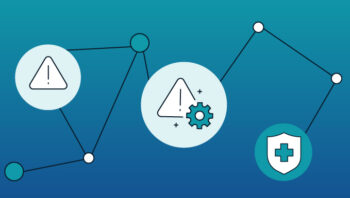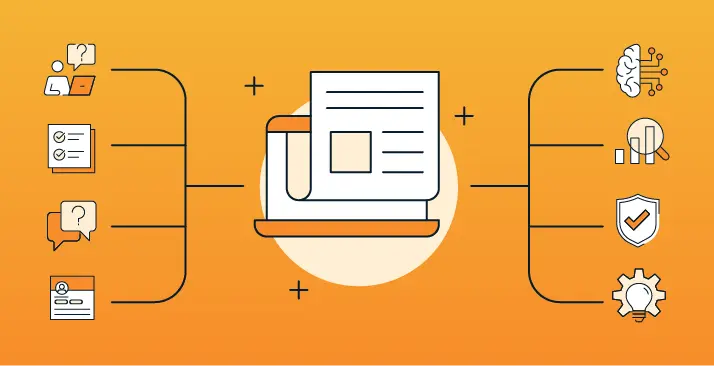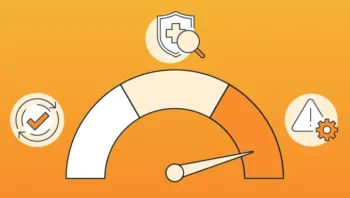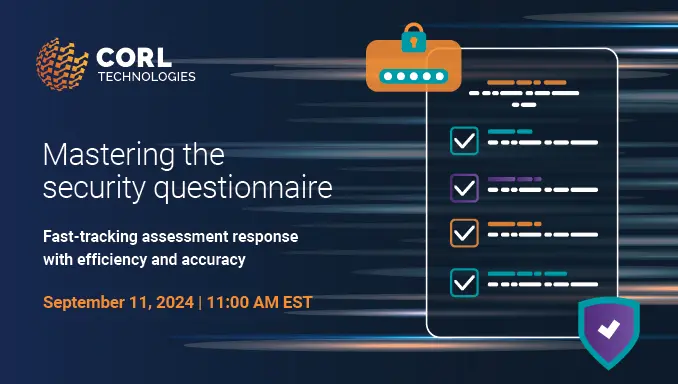
BlogTPRM
Top 10 Healthcare Supplier Risk Management Challenges Facing Providers in 2025
3 Minute Read
Read Top 10 Healthcare Supplier Risk Management Challenges Facing Providers in 2025Healthcare Contracting
By CORL Technologies | September 6, 2024

Consider a familiar scenario: you receive another security questionnaire and read through all 300 controls, thinking, “Haven’t I answered most of these questions before?” While you’ve certainly responded to these controls in the past, they are rarely asked in quite the same way. This is the central problem with the passive reuse of security questionnaire responses.
Question response reuse has long been a strategy to combat the crushing weight of vendor risk questionnaires. Initially done manually, by referencing past questionnaires to populate new ones, which eventually evolved into passive reuse tools that pull previous answers.
But fragmentation in question sets, rapidly changing cybersecurity requirements, and an uptick in time-sensitive elements have all made passive reuse increasingly untenable. In today’s dynamic cybersecurity landscape, a more advanced and proactive strategy is required.
AI can play a transformative role, enabling vendors to move beyond passive reuse and generate context-rich responses that are tailored to each request.
This blog post will explore ‘the old way’ and ‘the new way,’ contrasting passive reuse and AI-powered response, then present a tangible business case for vendors who are considering AI-powered questionnaire response.
The old way: Passive infosec questionnaire response reuse
With passive reuse, vendors pull from a bank of previously answered security questions to respond to matched prompts more efficiently in future questionnaires. This method is appealing, as it removes the need to create new responses for each infosec questionnaire. However, this practice has several shortcomings that can impact both scalability and response quality.
First and foremost, passive reuse requires a direct response match to be truly effective. This makes it useful for certain standardized assessments, like SIG questionnaires, but not for most standard security assessments, and especially those with industry-specific demands. In addition to question variance, some questions may read the same but have critical context—or client-specific considerations—that must be incorporated for a comprehensive and proper response. Passive reuse also misses this context.
In the event of multiple matches, passive reuse also falls short. Most passive reuse tools will default to the most recent response, or force stakeholders to carefully review and choose between multiple matches. The problem with this approach is that the most recent result is not necessarily the most relevant, and the task of reviewing and comparing responses requires more time and effort from IT teams. In many cases, the best response to a question will combine elements of multiple past questionnaires—but passive reuse can only reuse a single response, not generate a new one.
Beyond its failure to account for question context, passive reuse fails to adapt over time. As industry expectations and cybersecurity standards shift, responses become less relevant, diminishing in quality. This decline increases burden on IT teams for response review and even threatens the bedrock of client trust.
Finally, passive reuse neglects security measures such as HITRUST certifications, SOC 2 examinations, and security risk assessments, among others. These assets are a trove of relevant and validated security insight essential for questionnaire responses. By referencing historical questionnaire responses alone, passive reuse overlooks what is arguably the most vital source of vendor cybersecurity information. This challenge is even more problematic for innovative vendors new to the market or are entering a new vertical (like healthcare) which lack extensive historical data.
The shortcomings of passive reuse
The new way: AI-powered information security questionnaire response
The rise of AI has created a compelling new opportunity for vendors looking to move beyond passive response reuse and answer infosec questionnaires more efficiently, without sacrificing depth and accuracy. AI-powered response solutions address the multiple shortcomings of traditional passive reuse while unlocking new levels of precision, relevance, speed, and scalability.
An AI-powered questionnaire response solution extends beyond merely reusing previous answers. It understands the meaning behind questions, regardless of phrasing, allowing vendors to achieve a far superior match rate. In addition, AI-powered questionnaire response considers the full context of every question and questionnaire, including client-specific nuances, ensuring that the answers generated are not just a match but a meaningful one.
AI-powered responses consider the quality and relevance of information in the matching process. Rather than indiscriminately presenting the most recent response or requiring users to sift through past responses, the AI dynamically evaluates each response’s suitability for the current questionnaire.
Due to its use of generative AI, AI-powered questionnaire response can combine multiple past responses to generate a brand new one. This capability addresses the critical reality that new responses are not necessarily satisfied by old ones, at least not in their original form.
One of the most significant advantages of using AI in this context is its ability to evolve and improve continually. As vendors provide more information and feedback, the AI learns and adapts, enhancing the overall quality of the responses over time. Feedback is collected as the AI learns from the vendor’s adjustments, and the level of adjustments required continues to lower over time. This not only streamlines the process but also enables IT teams to shift their focus from exhaustive reviews and revisions to simple tweaks, saving time and reducing the potential for human error.
An AI-powered solution leverages all the vendor’s relevant cybersecurity documentation and artifacts—including profile data, existing documentation, assurances, and other available resources—to generate the best possible response. This is a stark contrast to passive reuse, which neglects critical information that falls outside the scope of previous questionnaires. By utilizing all available information, AI-powered questionnaire response solutions provide a more comprehensive and secure approach to questionnaire response—one that rewards a vendor’s collective cybersecurity efforts with efficiency gains in the questionnaire process.
The benefits of AI-powered response
Three important considerations in the vendor risk questionnaire response process
Ultimately, the measure of an AI-powered questionnaire lies in its ability to balance three vitally important factors without compromising the other: response velocity, response quality, and response privacy.
For example, while passive reuse has the potential to increase response velocity, it often comes at the expense of response quality. Responses are simply reused without considering context. With traditional manual response approach, responses are obviously private, but the process is marked by insufficient velocity and scale.
With the right solution for AI-enabled response, vendors can significantly increase both response velocity and response quality, while also safeguarding their sensitive data.
| Manual response | Passive reuse | AI-enabled response with CORL | |
| Response velocity | Low | High | High |
| Response quality | Moderate | Low | High |
| Response privacy | High | Varies | High |
The business impact of AI-enabled response
For vendors that are ready to advance from passive reuse and to an effective AI-powered solution, the benefits are far-reaching. They’ll dramatically reduce the time spent on questionnaires, enabling faster closures with new healthcare clients. On top of that, with fewer internal cycles for questionnaire completion and review, their team will be freed to focus on more meaningful and value-add initiatives, such as cybersecurity certifications and enhancements, and one-to-one client collaboration. In turn, they can strengthen security over time and foster a culture of transparency and trust—making them a more appealing partner for future healthcare clients.
Let’s consider a second hypothetical scenario to illustrate the potential benefits of AI-powered assessment response.
Let’s say a medium-sized vendor answers 50 security questionnaires each year. Historically, they relied on passive reuse, which matches only 10% of the questions, reducing the time spent on each questionnaire by just 8%. On average, it takes them 18.4 hours to complete each questionnaire, adding up to 920 hours annually.
With sales delayed and IT resources exhausted, the vendor decides to adopt an AI-powered solution for security questionnaire response. With AI, they achieve a 95% contextual match, slashing the time required per questionnaire by 90%. Instead of spending 20 hours per questionnaire, they can complete each one in just 2 hours. This reduces their annual time spent on questionnaire response to just 100 hours, freeing 820 hours to be redirected to other critical tasks.
By making the switch to AI, this medium-sized vendor not only enhances the quality and accuracy of their responses but also gains valuable time that can be invested back into their business.
Accelerate questionnaire response and grow trust with CORL Companion & CORL Cleared
AI powered questionnaire response has the potential to be transformative, but it must be coupled with an unwavering focus on reducing assessment volume and improving overall cybersecurity.
At CORL, we combine AI-powered assessment response with an achievable methodology for vendors to enhance their risk posture and potentially bypass future assessments altogether.
With CORL Companion, vendors can achieve unprecedented levels of efficiency in their infosec questionnaire response process. CORL Companion allows vendors to create a profile and upload security documentation and other supporting information, then utilizes that information to dynamically generate suggested questionnaire responses in minutes. CORL Companion’s AI model is secure and specialized in cybersecurity, delivering velocity, quality, and privacy at scale.
When paired with CORL Cleared, CORL Companion allows vendors to not only strengthen their cybersecurity posture and close deals faster, but to reduce questionnaire volume over time. Both CORL Cleared and CORL Companion are delivered inside CORL’s secure platform with no third parties involved, ensuring that your sensitive data remains yours alone.
If you’d like to learn more about how you can move from passive reuse to dynamic, AI-powered response, contact us.
 CORL Technologies
CORL Technologies
CORL transforms TPRM chaos into clarity
CORL is a leading provider of vendor risk management solutions for the healthcare industry. CORL gets results by scaling organizational and vendor risk programs through our healthcare vendor risk clearinghouse solution, dashboard reporting that business owners can understand, and proven workflows that drive measurable risk reduction. CORL accelerates the speed of vendor risk assessments and holds vendors accountable for remediating risk exposures.
Related Posts

BlogTPRM
By CORL Technologies | August 14, 2025
3 Minute Read
Read Top 10 Healthcare Supplier Risk Management Challenges Facing Providers in 2025BlogCompliance
By CORL Technologies | June 24, 2025
5 Minute Read
Read Unlocking Vendor Assurance: A Deep Dive into CORL Technologies’ Assessment Suite
BlogTPRM
By CORL Technologies | May 19, 2025
2 Minute Read
Read More Than a Checkbox: Why Right-Sizing Vendor Risk Remediation Is the Key to Smarter TPRM
Webinars
WEBINAR Mastering the Security Questionnaire Healthcare vendors are all too familiar with the notoriously painful process of responding to security questionnaires. It takes far too long, delays sales (sometimes indefinitely), and consumes a disproportionate amount of IT focus. Simple question reuse attempts to reduce duplicative efforts—but it requires an exact question match, which is a […]